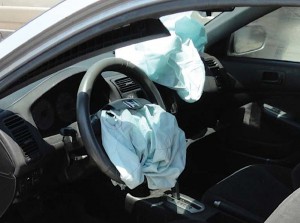They’re meant to be triggered by a crash, but in an unsettling number of situations, airbag inflators provided by Japanese supplier Takata have gone off far more aggressively than intended, a situation so far linked to at least 10 deaths.
Researchers working for a consortium of 10 automakers believe they finally have figured out why Takata airbags are prone to rupturing. They blame three factors, including manufacturing problems, exposure to high humidity, and the basic chemical used to inflate Takata airbags in the event of a crash,
The findings are the result of a year-long effort to explain the problem which has so far led to the recall of nearly 25 million vehicles in the U.S. – and which could lead to the recall of another 50 million vehicles using Takata inflators.
The results were set to be released on Tuesday, following a briefing for the National Highway Traffic Safety Administrations and congressional staff members.
The year-long study was set in motion has it became clear large numbers of vehicles using Takata inflators were at risk. Initially, it appeared that the problem was the result of a manufacturing defect at two of the supplier’s North American plants. Vehicles considered vulnerable were those being used in regions with high humidity, such as Southern Florida and Puerto Rico.
(Daimler recalls over 800,000 vehicles due to Takata issue. Click Here for more.)
But as the death and injury toll continued to rise, it became increasingly clear that Takata airbags were failing in other parts of the country – and when they did, they could send plastic and metal shrapnel spewing into the passenger compartment.
Explanations offered by Takata were considered incomplete, if not inaccurate. That led a group of 10 of the 14 manufacturers who have been hit by Takata recalls to form the research panel. They turned to a Utah-based rocket science company, Orbital ATK, to try to find the root of the problem.
Widely reported documents have since emerged referring to “chronic” quality control problems at the two Takata plants – one of which has since been closed. That appears to have made the inflators particularly vulnerable to inadvertent and unpredictable failure.
But a third ingredient has also been cited: the highly explosive ammonium nitrate that Takata has long used in its inflators. When triggered, the material produces a hurricane of hot gases, enough to burst an airbag out of its hiding place and fill it long enough to product occupants.
But there has been growing concern that ammonium nitrate can turn unstable over time – all the more so if improperly manufactured and then poorly protected from humidity and other factors that could cause it to break down over time.
The results of the study could be problematic for everyone involved, not just Takata, however.
As part of a consent decree it signed with NHTSA last year, Takata agreed to take steps to improve its handling of safety issues. It also agreed to phase out the use of ammonium nitrate. And, if it cannot demonstrate existing inflators are safe, it could be required to order additional recalls affecting as many as 90 million inflators – or about 50 million more cars, trucks and crossovers.
(How big could the Takata recall be before it’s over? Click Here for the latest.)
There is also concern that the replacement inflators Takata has been supplying may also be prone to failure. That could lead members of the consortium – a group including Honda, Toyota, General Motors, Ford and Fiat Chrysler – to have to order a second recall for some vehicles.
Additional recalls of vehicles so far considered safe could be put into motion by 2018 under the agreement Takata signed.
Even before then, the airbag recall has become the single-largest safety-related defect in U.S. automotive history, at least based on the number of vehicles that have so far been recalled.
(Now it’s seatbelts. Click Here to find out why Toyota is recalling 3 million vehicles.)



Shrapnel is not a component in airbag initiators. But surprised it takes 5-years to determine a cause for the problem. See, sometimes it does take a ‘rocket-scientist’!
Paul
Can you link to the report?